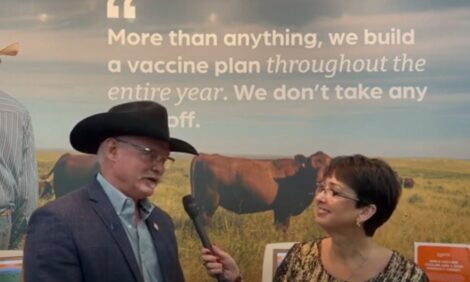



Zoetis Quick Tip: US-based Buford Ranch manages tough parasites
Parasite management is a foundation for herd health at Buford Ranch in Oklahoma, USAEfficiency and efficacy are the two things Doug Branch is looking for in a parasite control program. As manager of the Buford Ranch Osage Division in Oklahoma, Branch oversees a registered herd of Hereford cattle, a large part of the ranch’s commercial cow/calf herd and a registered Quarter Horse operation. Keeping the cows and calves healthy with a solid vaccination and parasite management program is important to the ranch’s success.
“With spring calving and fall calving herds, we are always doing something with the cattle,” said Branch. “We are fortunate that the cattle can graze the majority of the year, so managing our forages is critical. That is also why parasite management is so important for our operation.”
Branch noticed some rough hair coats showing up and it just didn’t seem like cattle were responding the same way after being treated with parasite control products. “I suspected that we had some resistance but wasn’t sure,” said Branch. “We agreed to participate in an Oklahoma State University research project about prevalence of resistant parasites in Oklahoma cowherds.”
As part of the project, university researchers pulled individual fecal samples on the ranch’s spring-born bred Hereford heifers to conduct fecal egg count reduction tests (FECRT). Half the heifers were treated with Dectomax Injectable and the other half received Ivomec Plus. Then, 14 days later fecal samples were pulled again. “The reduction of egg counts wasn’t as high as it should have been, indicating we were seeing some resistance issues with our parasite management program,” said Branch.
With that knowledge, Branch reached out to Dalton Brown, his Zoetis sales representative, and his local veterinarian, Dr. Trace Lenaburg, and Rick Clovis, the local Oklahoma State University extension agent, to discuss options. “I believe in pooling the best information from trusted experts when making decisions about herd health and nutrition,” said Branch.
Brown met with the ranch team and their veterinarian to tell them about Valcor (doramectin and levamisole injection), its two active ingredients and how the ingredients work together for effective parasite control.
In August 2023, Branch made the decision to use Valcor on the fall calving cows about a month before they began calving.
“We needed a person on each side of the chute to split the dosage, but it was still more convenient to use one product with a single administration type,” said the ranch manager. “It was also less stressful not needing to catch heads to administer an oral drench along with a topical product like we had done before under our veterinarian’s direction.”
The ranch also did another FECRT on the spring heifers, following the same protocol as the university research study. This time Branch treated the heifers with Valcor and saw a 99% reduction in fecal egg counts.
“The product works well, and we saw great results with our early use,” said Branch. “The cost to use Valcor is 70 cents more per head than using an oral drench and a topical parasite control product, but the convenience of using one product that is effective against potentially tough worms more than outweighs the additional cost.”
The results at Buford Ranch are similar to the results from research done on the product prior to and after it came to market. Valcor consistently exceeded 99% fecal egg count reduction in studies with more than 6,300 head of cattle in multiple locations across the country.


